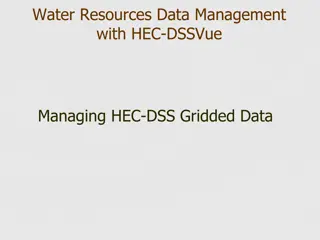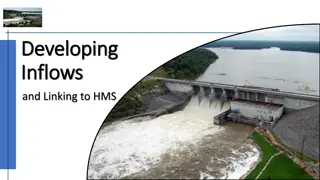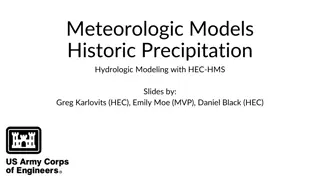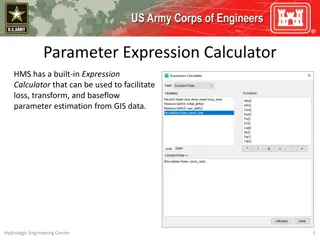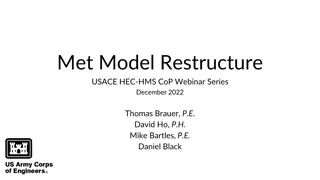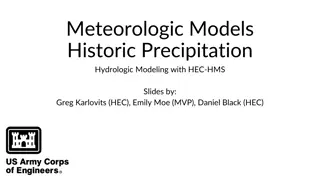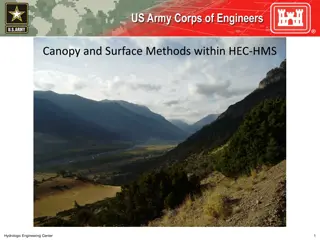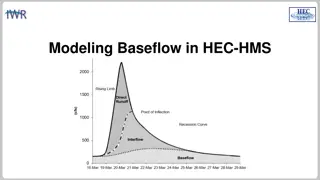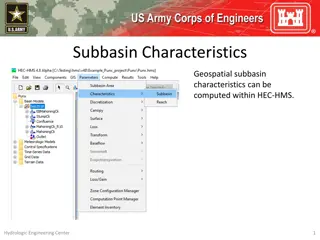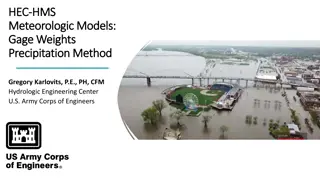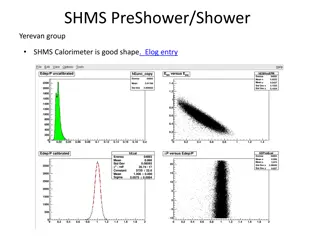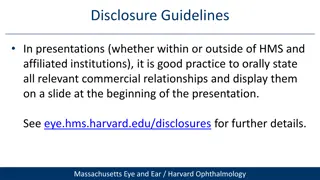Hydrologic Modeling Methods in HEC-HMS: A Comprehensive Overview
Explore the transformative methods within HEC-HMS hydrologic modeling, including unit hydrograph derivation, excess precipitation transformation, hydrograph illustration, surface transform methods, and concepts like the kinematic wave and 2D diffusion wave. Learn about the unit hydrograph, kinematic
0 views • 41 slides
Managing Water Resources Data with HEC-DSSVue
Learn about managing gridded data in HEC-DSSVue, including how grids represent spatial data, storing data in DSS, naming conventions, tools for manipulation, and more. Explore the importance of grids in hydrologic modeling and the application of spatial data in HEC-HMS and HEC-RAS.
4 views • 42 slides
Stochastic Storm Transposition in HEC-HMS: Modern Techniques and Applications
Explore the innovative methods and practical applications of Stochastic Storm Transposition (SST) in the context of HEC-HMS. Delve into the history, fundamentals, simulation procedures, and benefits of using SST for watershed-averaged precipitation frequency analysis. Learn about the non-parametric
3 views • 41 slides
Understanding Reservoir Inflows and Computing Methods
Explore the methods for computing reservoir inflows, including mass balance formulas, known and unknown variables, and techniques to handle negative values. Learn about linking to HMS for hydrologic engineering, estimating local inflows, and utilizing smoothing techniques for accurate results.
0 views • 24 slides
Hydrologic Modeling with Gridded Precipitation Data
Learn about utilizing gridded precipitation data for hydrologic modeling with HEC-HMS. Explore the advantages of spatially distributed precipitation sources such as RADAR and gauge comparisons, and understand the various national and regional products available. Discover utilities for converting and
3 views • 14 slides
Parameter Expression Calculator for Efficient Parameter Estimation from GIS Data
Parameter Expression Calculator within HEC-HMS offers a convenient tool to estimate loss, transform, and baseflow parameters using GIS data. It includes various options such as Deficit and Constant Loss, Green and Ampt Transform, Mod Clark Transform, Clark Transform, S-Graph, and Linear Reservoir. U
2 views • 5 slides
Restructuring of USACE HEC-HMS Meteorologic Model
Significant modifications have been made to the HEC-HMS meteorologic model to enhance modeling tasks' ease and intuitiveness. The Met Model Restructure updates in versions 4.9 to 4.11 streamline meteorologic processes, introduce new features like automatic linkages and zonal editors for snowmelt, an
0 views • 19 slides
Historic Precipitation Hydrologic Modeling with HEC-HMS Slides by Greg Karlovits, Emily Moe, Daniel Black
Delve into the world of hydrologic modeling with HEC-HMS through a detailed presentation by experts Greg Karlovits, Emily Moe, and Daniel Black. Explore meteorologic models, atmospheric boundary conditions, basin modeling, and simulation runs in this informative slide series.
0 views • 12 slides
Understanding Canopy and Surface Methods in HEC-HMS
Explore the various canopy and surface methods utilized in HEC-HMS for managing water resources. Learn about canopy interception, evapotranspiration, common parameter values, and factors affecting losses. Delve into available methods, canopy storage values, and surface depression storage. Enhance yo
0 views • 12 slides
Understanding Reach Characteristics in HEC-HMS Basin Modeling
Reach characteristics play a crucial role in hydrological modeling using HEC-HMS. Georeferenced reaches are essential for computing reach characteristics like slope, sinuosity, relief, and more. The process involves pre-processing drainage data before detailed reach characteristics can be obtained.
0 views • 5 slides
Understanding Baseflow Modeling in HEC-HMS
Baseflow in HEC-HMS plays a crucial role in modeling runoff volume, consisting of groundwater flow components like interflow and baseflow. Different approaches are used to model baseflow, with HEC-HMS currently incorporating conceptual methods. The response times for interflow and baseflow differ, i
1 views • 7 slides
Understanding Subbasin Characteristics in HEC-HMS
Subbasin characteristics play a crucial role in hydrological modeling within HEC-HMS. Before computing these characteristics, the basin model must have georeferenced subbasins in the GIS. Various parameters such as basin slope, relief, elongation ratio, drainage density, and flowpath lengths and slo
0 views • 13 slides
Understanding Gage Weights and Precipitation Methods in Hydrologic Modeling
Exploring the concept of gage weights and precipitation methods in hydrologic modeling using the HEC-HMS software. Dive into the pros and cons of flexible gage weighting, calibration processes, and best practices for estimating time and depth weights. Discover how to set up a gage weights model, inc
0 views • 11 slides
Understanding the Colorado Health Insurance Buy-In Program
The Colorado Health Insurance Buy-In Program, presented by HMS, Inc., aims to improve health care equity, access, and outcomes for Coloradans while saving money on health care. By partnering with Health First Colorado, the program offers cost savings, wider provider networks, and coverage of medical
0 views • 15 slides
James Lind's Experiment on Scurvy Treatments: A Historical Analysis
James Lind's 1747 experiment on HMS Salisbury to test scurvy treatments is considered a significant milestone in biomedical science. Despite being a poorly designed study by modern standards, Lind's work paved the way for advancements in understanding and treating scurvy. This analysis delves into L
0 views • 15 slides
Updates on Calorimeter and Cherenkov Detectors in Yerevan Group's SHMS and HMS
Check out the latest updates on the calorimeter and Cherenkov detectors of Yerevan Group's SHMS and HMS. The SHMS detectors are in good shape, while adjustments in HV are needed for the HMS Cherenkov detectors to achieve optimal performance. Images and descriptions are provided in the Elog entries.
0 views • 6 slides
Exploring the Evolutionary Journey of Charles Darwin
Discover the groundbreaking contributions of Charles Darwin to the theory of evolution through his voyage on the HMS Beagle, observations on the Galapagos Islands, study of finches and tortoises, and formulation of the theory of natural selection. His work revolutionized scientific understanding of
0 views • 30 slides
Exploring English Heritage: Images from Paul Berthelot's Estate
Discover a captivating collection of images showcasing English culture and architecture, acquired by Paul Berthelot during his time in the US Air Force stationed in England. From Battle Abbey in East Sussex to HMS Victory and The Mary Rose, immerse yourself in the rich history and beauty of these ic
0 views • 44 slides
Exploring the Legacy of HMS Saumarez and HMS Skipjack in the Royal Navy's History
Dive into the historical significance of HMS Saumarez and HMS Skipjack, two notable vessels of the Royal Navy's Mediterranean Fleet during the Palestine Patrol. Discover their missions, armaments, crew details, and commanding officers through a collection of fascinating images and detailed descripti
0 views • 41 slides
Steamship Authority Revised Mission Statement Development Progress
The Steamship Authority is undergoing a revision of its mission statement, a process initiated by the HMS Consulting recommendations in 2018. The development of the new statement involves community input and values such as customer engagement, sustainability, reliability, safety, and efficiency. A P
0 views • 16 slides
Guidelines for Commercial Disclosure in Presentations
It is essential to disclose all relevant commercial relationships orally and visually at the beginning of presentations, whether within or outside Harvard Medical School and affiliated institutions. This includes stating any financial ties, research funding, consultancy roles, shareholdings, and boa
0 views • 4 slides

